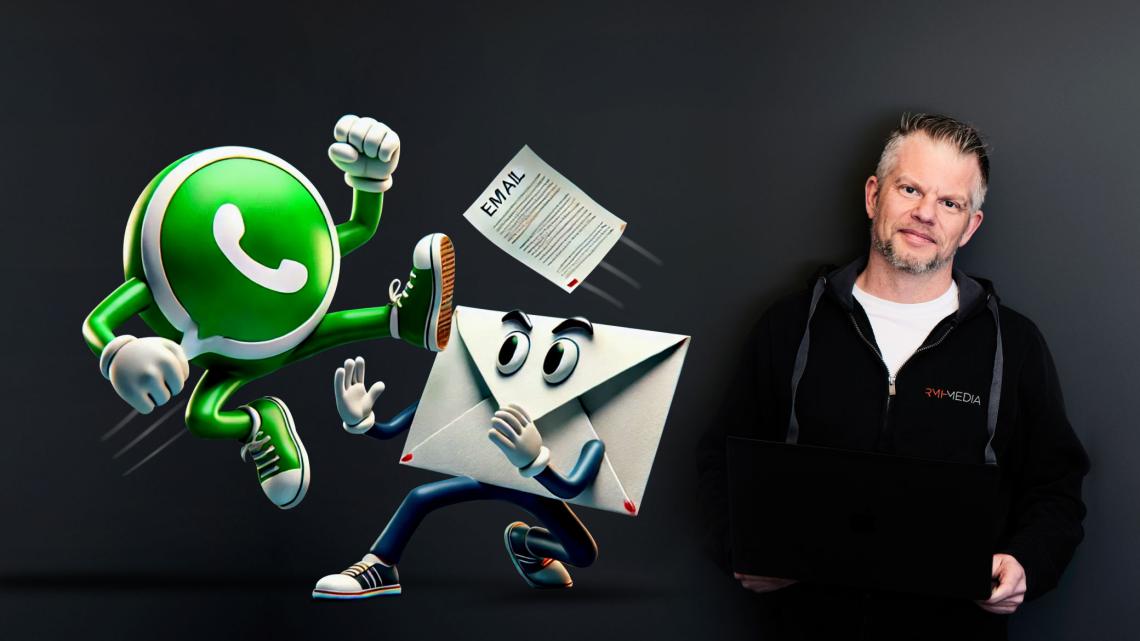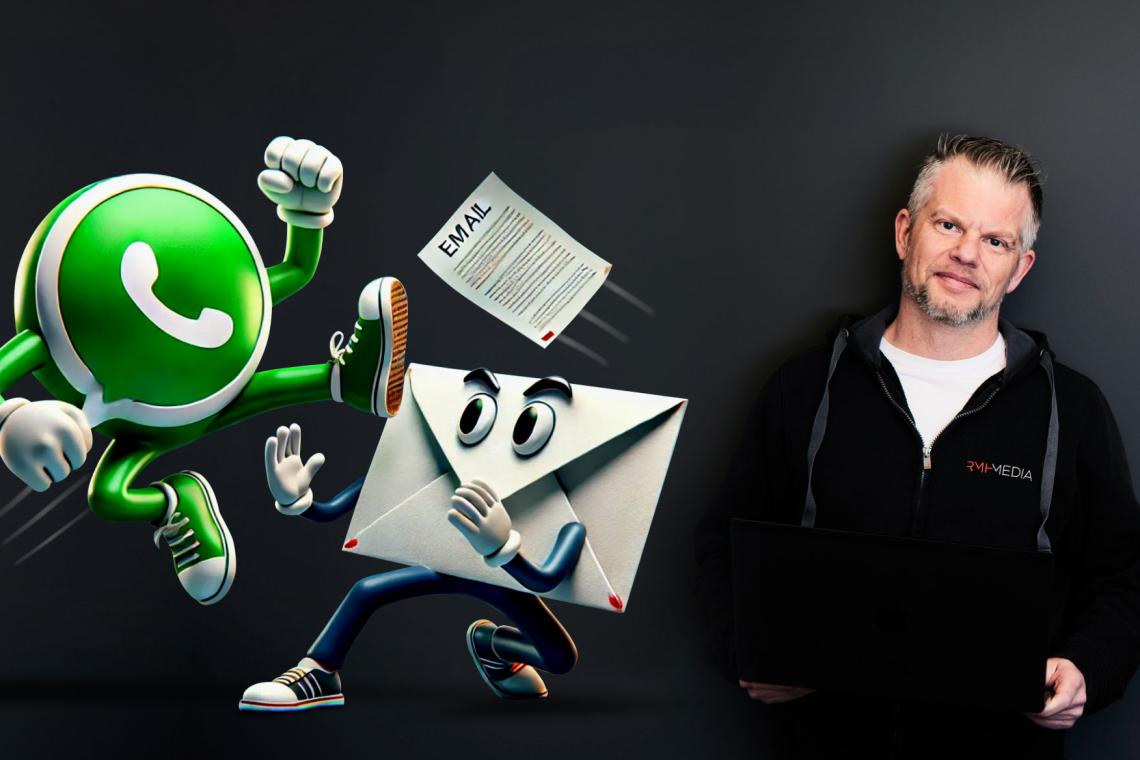

Email vs. Instant Message: A Battle for Effective Omnichannel Strategies
Pharmaceutical companies are evolving their communication strategies to keep up with the changing preferences of healthcare professionals (HCPs). An omnichannel approach—where multiple digital touchpoints are used to deliver a consistent, personalized experience—has become essential. But how can we effectively administer the right information, through the most suitable channels, at the optimal time—especially when our audience is overwhelmed with data, and engagement rates are constantly declining?
1. Introduction
The way HCPs interact with pharmaceutical companies continues to evolve rapidly, also driven largely by the digital acceleration caused by the pandemic. Even though we are allowed to visit our customers again, traditional face-to-face meetings and in-person conferences have been increasingly replaced by digital channels, where instant communication and personalized content are now expected. To maintain relevance and foster deeper relationships, pharma companies must adopt an omnichannel approach that offers a cohesive, seamless experience across all digital touchpoints.
In this whitepaper, we focus on two key communication tools—instant messaging and email—examining how each can be used effectively within an omnichannel framework. By understanding the strengths of these channels and how they complement each other, pharma companies can ensure they are engaging with HCPs in the most impactful ways possible.
2. Challenges of Communication in Pharma
Pharmaceutical companies face several hurdles when communicating with HCPs in addition to increasing complexity in their operations and supply chains . These challenges include regulatory compliance, data overload, and the need to adapt to different regional preferences:
Regulatory Compliance
Whether communicating via IM or email, ensuring compliance with global regulations such as GDPR and HIPAA is critical. Instant messaging offers speed and efficiency, but pharma companies must ensure that their platforms use secure, encrypted communication to protect sensitive patient information and medical data. Failure to meet these standards can result in significant fines—and even worse—a loss of trust among HCPs.
Information Overload
HCPs are overwhelmed with tons of content daily, from clinical trial updates to marketing emails - compounded by the number of pharmaceutical companies they engage with. This overload impacts the effectiveness of communications. To combat it, it is essential to send targeted, relevant content via the most appropriate channel. Instant Messaging, with its ability to deliver concise, interactive messages, is perfect for quick updates and real-time engagement. On the other hand, email allows for more in-depth communication when more detail is needed .
Regional Device Usage:
Device preferences vary significantly across regions. In emerging markets, where desktop or laptop usage may be less common, smartphones dominate as the primary device for accessing the internet. This has significant implications for communication strategies. Instant messaging, with its mobile-first design, should be the focus in these regions, offering a better fit for HCPs’ daily digital behaviors . On the other hand, in regions where desktop usage is more prevalent, email may be the preferred channel for more comprehensive, document-based communications .
3. Instant Messaging vs. Email: A Comparative Analysis or how to pay back Trust
Fom a technical standpoint Instant Messaging is a close relative of the traditional email—both are simple pieces of HTML, distributed via a unique identifier to a specific recipient. However, that’s where the similarities end. The way customers engage with these two channels is vastly different.
While overloaded inboxes, spam, and irrelevant emails have left us fatigued, Instant Messaging still provides a more personal, uncluttered space for meaningful communication. We instinctively pick up our mobile phones the moment a notification buzzes, but we only begrudgingly sync our email inbox two or three times a day, often out of necessity.
However, gaining access to an HCP‘s most personal device, their mobile phone, comes with the responsibility: to deliver high-quality, relevant content. Fail to do so, and you risk losing their trust—and their consent—almost instantly.
Instant Messaging—real-time, interactive, personal
Instant Messaging is most effective for delivering short, engaging content such as videos, surveys, or event reminders. Because it aligns well with the way HCPs use their smartphones, it is a powerful tool for driving immediate action and real-time responses. Instant messaging shines at fostering more personal, conversational interactions and can be used to prompt HCPs to register for events, complete surveys, or quickly access educational resources. Ensure that the content is easy to consume and encourages immediate action.
Example: Sending a quick reminder about an upcoming webinar, complete with a one-tap registration link, is an ideal use of IM. Its ability to deliver real-time updates makes it highly effective for time-sensitive content like clinical trial enrollment deadlines or new drug approvals.
Email—formal, asynchronous, structured
Email remains the go-to channel for more formal, detailed communication. It allows for the distribution of long-form content like clinical trial results, regulatory updates, or comprehensive report PDFs. This content must be structured for easy navigation, allowing HCPs to review and revisit at their convenience. Including attachments and links to additional resources can further enhance the value of email communications.
Example: A detailed email outlining the results of a new drug trial, with links to additional resources and attachments for in-depth reading, ensures HCPs can review critical information at their own pace. Email is also ideal for sending regulatory and compliance-related updates that require careful consideration.

By combining the strengths of both channels, pharma companies create a balanced, effective communication strategy that caters to HCPs‘ needs and preferences.
4. Best Practices for Pharma’s Instant Messaging Strategy
To maximize the effectiveness of instant messaging within an omnichannel strategy, it’s essential to tailor content for quick consumption while maintaining relevance. Here are some of the most critical success factors:
-
Interactive Content: Instant Messaging is perfect for engaging, interactive content such as videos, surveys, and registration forms. This kind of content encourages HCPs to act immediately, driving real-time engagement (‚Watch this 2-minute video on new treatment guidelines and share your feedback via this quick survey.‘).
-
Tailoring Content by Region: Regional preferences must obviously be considered when crafting an omnichannel strategy. In regions where mobile usage is dominant, such as emerging markets, Instant Messages should take priority. Mobile-optimized content ensures messages are both accessible and relevant to HCPs’ daily habits. In mobile-first regions, sending a short IM with a registration link for an event will likely generate higher engagement than a detailed email.
- Timely Delivery & Frequency: Instant Messaging excels at delivering time-sensitive updates, but it’s crucial to avoid overloading recipients. Pharma companies should ensure they are sending messages at optimal times to maximize engagement. Additionally, balancing Instant Messages with email for more detailed follow-up can help maintain a healthy communication cadence without overloading HCPs.
5. A Business Case: When Two become One
We have seen that both instant messaging and email have their distinct advantages, and their impact becomes even more significant when used together effectively. Now, let’s elevate our perspective from a focus on individual channels to a holistic view of the customer experience.
The Scenario
Imagine we have an upcoming congress with keynotes and break-out session over two days. Attendees have to register for each session.
The Journey
Step 1 - Event Invitation
All potential participants receive an invitation by email. The email is well-structured and includes essential details such as keynote speakers, venue location, a booking link, and the full agenda.
Channel Requirements: Given the complexity of the content, including multiple topics and tables like the event agenda, email is a perfect fit for a rep-triggered email or a marketing email.
Step 2 - Managing Attendee Flow
In the afternoon before the event, we notice that one particular session has low registration numbers. Additionally, we observe that a number of participants haven’t yet selected any sessions. We send out an instant message with a video interview of the speaker and a link to register for the session in order to boost interest.
Channel Requirements: We know that our participants are likely travelling or have just reached the event location. Contacting them with an instant message will lead to a faster response and is more convenient for them.
Step 3 - Engaging during Event
We aim to deliver a valuable learning experience, and gaining insights into participant feedback is critical for us. At the end of the session, we offer our customers a chatbot poll delivering insights on content quality of the session.
Channel Requirements: Our customer is likely still sitting in the conference room, waiting for the next session. An Instant Message with a direct interaction possibility is the perfect channel for this occasion.
Step 4 - Cool down and Warm Up
A few days have passed, and our customer is back at home. He has received an email with links to all slide decks of the sessions he visited during the congress. We also included a sneak preview on the agenda of the next event and a link for early registration.
Channel Requirements: We have a variety of topics, again begging for structure. In addition, we can assume, that our participant has access to his computer again, so he is able to digest extensive documents like presentations. Email is the perfect channel in this case.
This example demonstrates that the selection of communication channels should be driven by customer experience. If we are offering the right channel at the right time, we are already another step closer to a true Omni-Channel experience.
6. Conclusion
In an increasingly digital world, pharma companies must adopt a comprehensive omnichannel strategy to engage HCPs effectively. Instant messaging and email each play distinct but complementary roles in this strategy. Instant Messaging is best suited for delivering interactive, real-time content, while email excels at providing detailed, long-form information. Understanding the strengths of each channel and tailoring content to regional preferences ensures that pharma companies can build stronger, more effective relationships with HCPs.
By integrating Instant Messaging and email into a cohesive omnichannel approach, pharmaceutical companies can ensure they are providing HCPs with the right content, at the right time, through the right channels—improving engagement and driving better outcomes.
You can download the white paper here:

Does instant messaging play a role in your omnichannel strategy yet?
Best practices in omnichannel marketing have evolved significantly in recent years. Let's compare notes in a short call on how to build stronger, more effective, and more personal relationships with HCPs.
